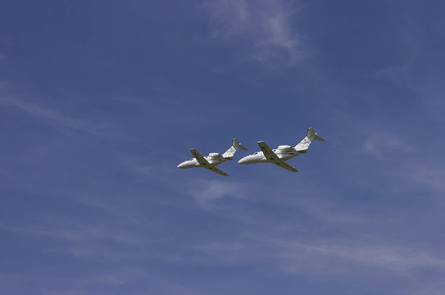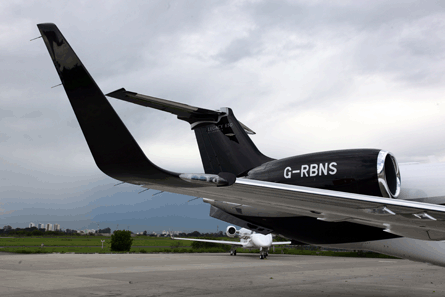Business aviation operators are calling for the threshold to qualify for using Eurocontrol's emissions trading scheme support facility to be raised in order to reduce administrative burden, as they brace themselves for a financial hit when their mandatory inclusion in the European Union's emissions trading scheme becomes a reality next year.
The support facility allows certain business aviation operators to enter their emissions data into a spreadsheet that uses modelling to estimate fuel consumption, significantly reducing the administrative cost and effort of complying with ETS data submission requirements.
However, at present only operators with fewer than 243 flights in three consecutive four-month periods, or annual carbon dioxide emissions of less than 10,000t, are permitted to use it, something the European Business Aviation Association is seeking to change.
 |
|---|
© London Executive Aviation
|
"We are asking the [European] Commission to raise this threshold in accordance with the required accuracy of this facility," says EBAA chief operating officer Pedro Vicente Azua.
The EBAA wants the 10,000t threshold to be raised to 50,000t or 100,000t "so more small emitters can benefit from simplified monitoring and reporting".
"Eurocontrol calculated there are 3,600 operators coming into Europe - of those, 2,000 are small emitters [below 10,000t]. If you raise it to 50,000t or 100,000t you would have an additional 1,000 [operators with fleets of 10-12 aircraft] who could then use the Eurocontrol support facility," says Azua.
Around 80% of EBAA's members have five aircraft or fewer in their fleets, meaning that the "administrative impact is huge", says Azua. "The problem is that because the decision to include business aviation operators was taken at the last moment, ETS was developed for airlines and big enterprises."
Conversations about raising the threshold have taken place at EC level, but Azua believes the Commission will wait until member states begin to complain about the bureaucracy involved with the current system before taking action. "We're hoping member states have already started to realise and early next year will recognise it, and we'll then be able to go back to the Commission and say that certain things need to be changed."
SUPPORT
The facility was ready for operators to use on 15 March, just in time to meet the 31 March deadline for submitting emissions data to the EC. It was delayed by "political problems", says Azua, but "it's good, it works and it reduces the administrative burden". Such is that burden, he adds, that "the administrative impact has more economic impact than the actual compensation for emissions".
As it stands, business aviation operators will likely have to compensate for about 90% of their emissions under the ETS. However, Azua believes that because of additional administrative costs associated with applying for the available free credits, many operators "won't even bother and will just compensate for 100% of their emissions". The EBAA estimates total administrative costs for each operator will amount to between €50,000 ($72,464) and €70,000 per year, including verifications and dealing with member states.
 |
|---|
© London Executive Aviation |
If administrative costs can be brought down, the EBAA has no problem with being part of the ETS, says Azua, despite what it sees as an unfair bias which will leave large commercial airlines having to pay for a much smaller percentage of their emissions. "Our members understand and completely support ETS in terms of compensating for their emissions, even though the parameter taken for free credits means our operators have to compensate for 90% of the emissions they use while airlines only compensate for around 10% of their emissions."
However, not all business aviation operators are as scathing about the administrative process of collecting and submitting their emissions data. For instance, George Galanopoulos, managing director of London Executive Aviation - which does not qualify to use the Eurocontrol support facility - says that "administration-wise, it has not been as bad as we thought it would be".
He adds: "We developed a report that counts the fuel we burn, converts it to CO2 tonnage and comes up with a report on a monthly basis. It doesn't take long." London Executive Aviation submitted its emissions data to the EC - after it had been externally audited - two days before the 31 March deadline.
Galanopoulos is more concerned about the effect on the bottom line of paying for emissions, which he estimates will cost London Executive Aviation around €100,000 per year. "We estimate that we will use some 8,000-10,000t a year. Taking the expected allowance into account and a price per tonne of €11-16, we estimate an initial cost of €100,000 a year," he says.
"The position of the industry at the moment is that it's going to be a considerable cost. It is unlikely that we'll be able to pass the cost on to our customers - this is a competitive business. So it has to come off the bottom line."
Azua agrees, noting that "it is going to be hard for business aviation operators to pass on the cost because their profit margins are already reduced to the maximum".
London Executive Aviation has yet to decide on its strategy for buying carbon credits, but plans to "work out the most cost-efficient way of buying".
Galanopoulos asserts that ETS "has nothing to do with saving the environment, it's about lining the Treasury's coffers". The sting for UK-based business aviation operators, he adds, will be all the more painful because it follows on from other inflated government fees. "Over the last two years we've had a considerable increase in CAA fees - from £20,000 a year to £70,000-80,000."
Source: Flight International



















